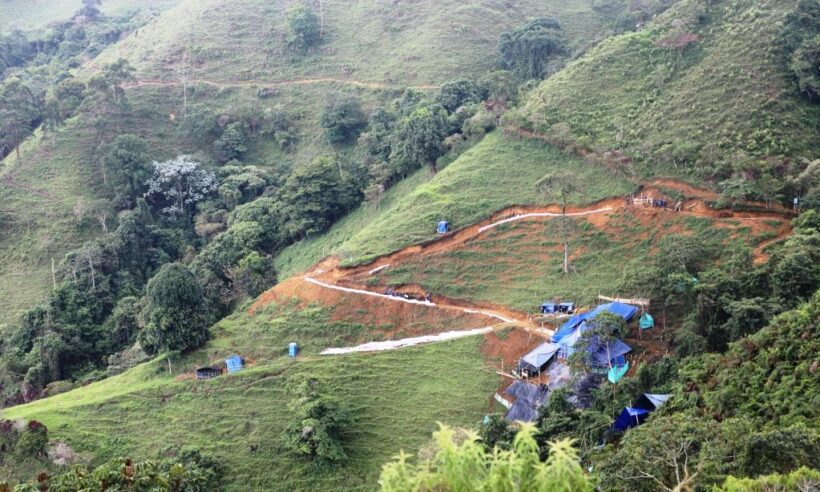Collective Mining Expands Apollo System’s Ramp Zone with High-Grade Intercepts in Colombia
Collective Mining Ltd (CNL), a mining company with assets in Colombia focused on gold, silver, copper, and tungsten, has released assay results for two diamond drill holes from the deeper Ramp Zone, situated at the base of the Apollo system within its Guayabales Project in Caldas, Colombia. The results confirm the continuous nature of reduced intrusion-related gold mineralization within the target area.
The Apollo system, which initiates at the surface, has now been traced vertically over 1,300 meters and remains open for expansion at depth.
Drill Program Results and Expansion
The reported assay results stem from two holes designed to extend the high-grade Ramp Zone laterally and vertically. The Ramp Zone is a key component of the Apollo system, located at the Guayabales Project.
The first hole, APC103-D6, was a shallower intercept that extended the system approximately 50 meters laterally to the northeast.
APC103-D6 intersected 50.50 meters grading 5.66 g/t gold and 13 g/t silver from 526.10 meters downhole.
This includes 8.80 meters at 10.56 g/t gold and 23 g/t silver.
A second high-grade sub-interval measured 17.95 meters at 9.48 g/t gold and 18 g/t silver.
The second hole, APC106-D2, represents the deepest drilling to date into the Ramp Zone. This intersection expanded the zone approximately 200 meters to the east and 50 meters vertically beyond previous drilling, reaching approximately 1,300 meters below surface.
APC106-D2 cut 70.00 meters grading 2.00 g/t gold and 5 g/t silver from 693.80 meters downhole.
This included 25.05 meters at 3.44 g/t gold and 7 g/t silver.
The Ramp Zone has been defined through localized drilling over a horizontal area of 275 meters of strike and 200 meters vertically. The zone remains open in all directions, and the total vertical dimension of the Apollo system has now been traced from the surface.
Comparative Geology and Operations
The Ramp Zone, which begins at approximately 1,000 meters below the surface, is characterized as a reduced intrusion-related gold system. The mineralization exhibits similarities to the Marmato Deeps deposit, owned by Aris Mining Corporation (ARIS), located 1.75 kilometers to the southeast. Both systems share similar gold-bearing sulfide mineral assemblages and commence at comparable elevations. The Marmato Deeps deposit has an NI43-101 resource estimate of 3.76 million ounces of gold (Measured plus Indicated) at 2.54 g/t gold.
Collective Mining attributes the comparatively higher gold grades observed thus far at the Ramp Zone to two primary factors:
- Mineralization is primarily hosted within a breccia structure, which offers greater porosity for metal-bearing fluid deposition than the porphyry host rock observed at Marmato Deeps.
- The Ramp Zone mineralization is locally overprinted by high-grade late-stage porphyry veins (CBM veins), which contribute to the overall grade.
The company is currently utilizing two new large-capacity rigs in its Ramp Zone drilling efforts, including the first directional hole (APC-140D1), which has cut mineralization visually assessed as consistent with the Ramp Zone target. The stated objective of the ongoing drilling program is to extend the Ramp Zone by at least an additional 200 meters both vertically and laterally along strike.
Seven rigs are focused on the Guayabales Project, targeting both the expansion of the Ramp Zone and new greenfield prospects. The company reported a treasury of approximately $70.6 million USD as of the end of Q2 2025.
Acquisitions and Infrastructure Development
Collective Mining announced the acquisition of additional surface and mineral rights within and surrounding the Guayabales Project area.
The acquired surface rights cover the entirety of the Apollo system and are intended for future infrastructure development. Payments for the surface rights are scheduled through 2029, beginning with a Q4 2025 payment of $4.75 million USD.
The acquired mineral rights predominantly consist of licensed mining titles, intended to consolidate gaps within the project area. Payments for the mineral rights are scheduled through 2030, with an initial Q4 2025 payment of $2.8 million USD.
Collective Mining site. Photo: Loren Moss




























